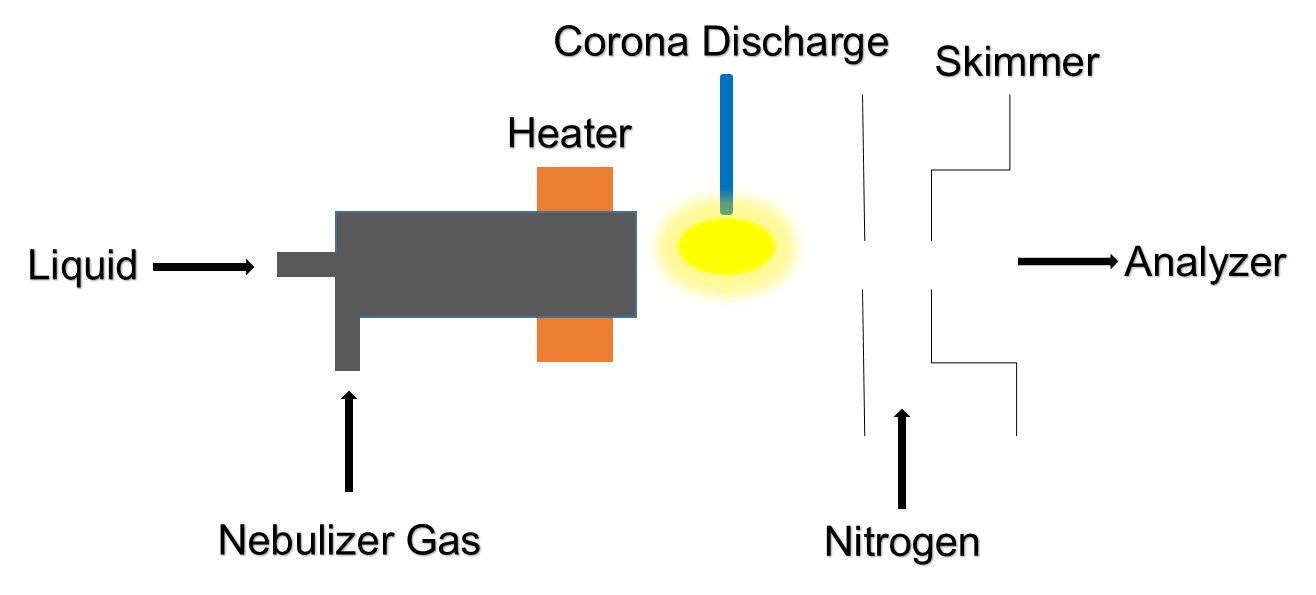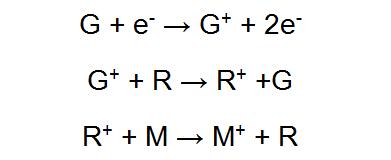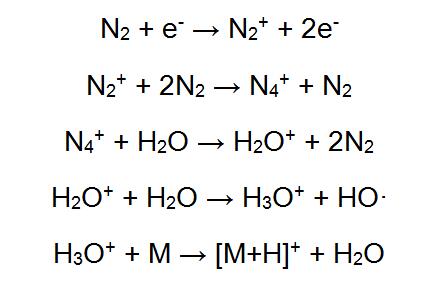Atmospheric pressure chemical ionization (APCI) is a new ionization method that is primarily used as an interface technology in high performance liquid chromatography and mass spectrometry. APCI has a wide ionization range, high sensitivity and high selectivity. It matches the high-efficiency separation ability of liquid chromatography, making liquid chromatography-atmospheric pressure chemical ionization mass spectrometry a standard analytical technique in the field of biological and environmental chemistry.
The Principle of APCI
 Figure 1. Schematic illustration of the APCI.
Figure 1. Schematic illustration of the APCI.
With gas assistance, the solvent and sample flow through the injector. The solvent and sample are vaporized by the heater in the injector and ejected from the injector outlet. At the outlet of the injector, the solvent is ionized by electro-acupuncture corona discharge. The solvent ions react with the sample molecules to ionize the sample.

In the above formula, G represents a reaction gas, R represents a solvent, and M represents a sample molecule. When N2 is used as the reaction gas and water is used as the solvent, the above reaction is:

This reaction process is very similar to traditional chemical ionization. The difference is that conventional chemical ionization is the electron bombardment of a solvent under vacuum to ionize it, while atmospheric pressure chemical ionization is to ionize the sample by a discharge needle corona discharge at normal pressure. Atmospheric pressure chemical ionization is mainly used to analyze samples with good thermal stability. Compared with electrospray ionization, APCI has the advantage of a wider range of mobile phase adaptation.
Advantages and Disadvantages of APCI
APCI produces a singly charged product, and the product molecular mass spectrum can be directly observed. That is, APCI does not suffer from the problem of multi-charged ion products leading to signal overlap and reduced resolution of the mass spectrum. APCI must vaporize the sample and is therefore suitable for the analysis of weakly polar compounds with good thermal stability and low proton affinity. In terms of mobile phase flow rate, APCI can accommodate higher flow rates than ESI.
In addition, APCI is not suitable for the analysis of biological macromolecules because it cannot generate a series of multi-charged ions. APCI produces very few fragment ions and therefore has limited structural information.
Examples of APCI Applications
APCI greatly reduces the contamination of the sample by the mass spectrometer, which provides conditions for the application of tandem mass spectrometry. The mass range of APCI source mass spectrometry can reach 25000 (m/z). It greatly exceeds the mass analysis range of conventional quadrupole and ion trap mass spectrometry, enabling LC-APCI-MS/MS to be used to analyze non-covalent complexes.
- Determination of harmful substances in tobacco
APCI combined with high performance liquid chromatography and mass spectrometry has important applications in the measurement of harmful substances in tobacco. HPCL-APCI-MS/MS exhibits excellent detection ability for carbonyl compounds and glycoside compounds in tobacco. By detecting solanesol in tobacco, the method has a detection limit of 0.4 μg/L. The content of heterocyclic amine in eight cigarette samples was determined by liquid chromatography tandem quadrupole mass spectrometry in APCI mode. The detection limit was 0.042~2.8 ng/branch, and the recovery rate was 68%~108%.
- Profiling of human stratum corneum ceramides
Ceramide is essential for maintaining the barrier function of the skin. Many skin diseases are known to be associated with ceramide profiles. Using a combination of APCI-mass spectrometry and normal phase chromatography to obtain a mass spectrum of nine ceramides known to exist helps us understand the underlying molecular mechanisms that ultimately lead to new diagnostic protocols. For example, the mass spectrum of patients with severe skin disease (such as atopic dermatitis and psoriasis) can be compared to the mass spectrum of the healthy controls.
- The classification and prediction of cheese maturity
APCI mass spectrometry combined with gas chromatography-mass spectrometry was used to study the presence of volatile compounds in cheeses of different maturity. This technique can correctly predict the age of cheese according to the characteristics of different mature stages of cheese, providing a 70% success rate. In addition to predicting maturity, the results of the analysis combined with chemometrics for rapid and detailed analysis of volatile components of cheese provide a basis for quality assessment and accelerated product development.
- Analysis of drugs and their metabolites
APCI forms a single-charged product that is much more sensitive than electrospray, thermal spray, and ion beam sources, making it easier and faster to analyze drugs and their metabolites. APCI can give results within 8 minutes for quantitative analysis of 8 phthalic acid derivatives in human urine. Meanwhile, APCI can also quickly and sensitively analyze flavonoids, sulfonamides and pentafluorobenzene derivatives.
LC-APCI/MS has the characteristics of simple operation, high sensitivity and clear signal. It has a wide range of applications in medicine, environment, chemistry and agriculture. With further development and optimization, APCI will be used in various applications.
We have briefly introduced the APCI, a type of ionization methods, which can help you understand more about mass spectrometry. At Creative Proteomics, we have the professional mass spectrometry platform, which contains different instruments. By using mass spectrometry, Creative Proteomics can provide different services to meet various requirements, including:
References
- Yang S, et al. Detection of Melamine in Milk Products by Surface Desorption Atmospheric Pressure Chemical Ionization Mass Spectrometry. Analytical Chemistry, 2009, 81(7):2426-36.
- Tao P, et al. Identification and determination of glycosides in tobacco leaves by liquid chromatography with atmospheric pressure chemical ionization tandem mass spectrometry. Journal of Separation Science. 2007:289–296.
- Farwanah H, et al. Profiling of human stratum corneum ceramides by means of normal phase LC/APCI-MS. Analytical & Bioanalytical Chemistry, 2005, 383(4):632-7.
- Heng Hui G, et al. Development and validation of an APCI-MS/GC-MS approach for the classification and prediction of Cheddar cheese maturity. Food Chemistry, 2016, 190(7):442-7.
- Arinobu T, et al. Comparison of SSI with APCI as an interface of HPLC-mass spectrometry for analysis of a drug and its metabolites. Journal of the American Society for Mass Spectrometry, 2002, 13(3):204-208.






